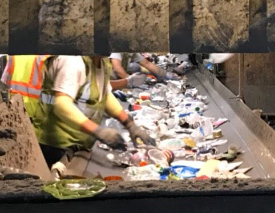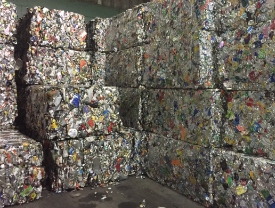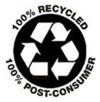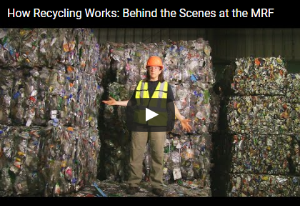Vermont State law bans certain items and materials from disposal in the trash, requiring recycling, composting, or other safe management options. However, there is no single recycling pathway, because every material has its own story. Exactly what happens to your stuff also depends on what part of the state you live in, because every waste district and independent town makes its own decisions about how to manage materials. Always reach out to your local solid waste management entity or town for more information about specific recycling programs and resources in your community.
What Happens to My Stuff?
Blue-bin Recycling:
 Blue-bin recycling includes glass bottles and jars; plastic bottles, jugs, and tubs; office paper/paper mail; cardboard; and steel and aluminum cans. These materials go to a Materials Recovery Facility, or MRF (rhymes with “smurf”). In Vermont, we have two large MRFs, one in Rutland and one in Williston, which handle roughly 70% of Vermont's recyclables. Other smaller MRFs manage the remainder of Vermont's blue-bin recycling. At the MRF, machines and humans sort the material by type. After sorting, individual material types are compressed into bales, which are sold to processors. Glass is separated into piles and sometimes ground to a fine sand-like texture. Contaminated recyclables and trash items that should not have been recycled are sent to the landfill. Generally, contamination at Vermont's MRFs is 10% or less of the material collected. That means about 90% of what is brought in for recycling goes out to be recycled.
Blue-bin recycling includes glass bottles and jars; plastic bottles, jugs, and tubs; office paper/paper mail; cardboard; and steel and aluminum cans. These materials go to a Materials Recovery Facility, or MRF (rhymes with “smurf”). In Vermont, we have two large MRFs, one in Rutland and one in Williston, which handle roughly 70% of Vermont's recyclables. Other smaller MRFs manage the remainder of Vermont's blue-bin recycling. At the MRF, machines and humans sort the material by type. After sorting, individual material types are compressed into bales, which are sold to processors. Glass is separated into piles and sometimes ground to a fine sand-like texture. Contaminated recyclables and trash items that should not have been recycled are sent to the landfill. Generally, contamination at Vermont's MRFs is 10% or less of the material collected. That means about 90% of what is brought in for recycling goes out to be recycled.
Want to learn more?
- Check out this behind-the-scenes video of the Williston MRF.
- See for yourself by touring a MRF. The Chittenden Solid Waste District offers seasonal public tours of the Williston facility (reservations required) and tours for schools and other groups by appointment. Tours of the Rutland facility can be arranged for groups.
 After the MRF, every material has a different journey. Materials go to processing facilities where, for example, cardboard is pulped and aluminum is smelted and rolled into sheets, before being sold to manufacturers. Ground glass can be used in place of natural stone aggregate, as a component in abrasives, in fiberglass insulation, or as an additive to products like paint and concrete. Casella Waste Systems, which finds end users for a lot of Vermont's blue-bin recycling, commits that 100% of non-contaminated recyclables that it receives and processes are sold to end markets to be made into new products or put to beneficial use. Vermont’s recyclers work hard to find good markets for recyclable materials.
After the MRF, every material has a different journey. Materials go to processing facilities where, for example, cardboard is pulped and aluminum is smelted and rolled into sheets, before being sold to manufacturers. Ground glass can be used in place of natural stone aggregate, as a component in abrasives, in fiberglass insulation, or as an additive to products like paint and concrete. Casella Waste Systems, which finds end users for a lot of Vermont's blue-bin recycling, commits that 100% of non-contaminated recyclables that it receives and processes are sold to end markets to be made into new products or put to beneficial use. Vermont’s recyclers work hard to find good markets for recyclable materials.
Some examples of facilities where Vermont's blue-bin recyclables go include:
- Canusa Hershman, St Albans, VT (mixed paper)
- Green Fiber, PA (mixed paper)
- APC Paper, Claremont, NH (cardboard)
- WestRock, Atlanta, GA (cardboard)
- Anheuser-Busch Recycling Corp (aluminum cans)
- Schnitzer Steel (aluminum and steel cans and scrap metal)
- KW Plastics, Troy, AL (HDPE and PP plastics)
- 2M Ressources, Quebec (glass)
Buy Post-Consumer Recycled (PCR) Content Products!
 When we purchase items made with recycled content, we help to close the loop of recycling. There are two types of recycled content. Pre-consumer content, or industrial recycled content, is recycled material from the manufacturing processes. Post-consumer recycled content is recycled material from containers and packaging that customers bought, used, and recycled. When you’re making purchasing decisions, look for information on the package about post-consumer recycled (PCR) content; it’s often near a recycling symbol. The higher percent of post-consumer content, the more your purchase directly supports recycling systems.
When we purchase items made with recycled content, we help to close the loop of recycling. There are two types of recycled content. Pre-consumer content, or industrial recycled content, is recycled material from the manufacturing processes. Post-consumer recycled content is recycled material from containers and packaging that customers bought, used, and recycled. When you’re making purchasing decisions, look for information on the package about post-consumer recycled (PCR) content; it’s often near a recycling symbol. The higher percent of post-consumer content, the more your purchase directly supports recycling systems.
Trash:

The majority of trash produced in Vermont ends up at the New England Waste Services Vermont landfill (NEWS VT), in Coventry, and some goes to landfills and incinerators in other states, like New York and New Hampshire. Special wastes, such as those generated by industry or from cleanup of contaminated soils, are evaluated and pre-approved before disposal. No hazardous wastes can be disposed in Vermont landfills.
Before the late 1980s, many landfills in Vermont were unlined, large holes in the ground, filled with trash. Today, landfills are highly engineered, designed, and regulated. While an entire landfill can be quite large, trash is deposited in one active area at a time. Once a section of a landfill is full, the material is "capped" with a plastic liner and soil. In the active section, landfill operators compact new waste material as it is delivered. Each night, the area is covered so trash doesn't blow around or attract animals.
State law requires that active landfills are double-lined, and any water in the landfill (leachate) is collected and processed at wastewater treatment facilities. The double-liner is monitored in case any leachate leaks through the primary liner. Ground water and surface water around the landfill is monitored twice a year, to test for a multitude of pollutants.
Food scraps and other organic materials in a landfill break down anaerobically (without air or oxygen). As they break down, they release methane, a powerful greenhouse gas. Within the landfill, a vacuum piping system collects most of the methane and other gasses. This landfill gas is combusted using engines that create electricity. Any excess gas collected is burned in flares.
How does composting food scraps compare? Composters regularly mix compost piles containing food scraps, leaves, and wood chips to incorporate air into the piles. This air prevents methane gas from forming, reducing overall greenhouse gas emissions. If Vermonters composted their food scraps instead of putting them in the trash, it would be the same as taking more than 7,000 vehicles off the road each year.
What can I do?
All Vermonters have two roles: properly managing their materials, and working to waste less. Together, we can acheive Vermont's goals of generating less waste overall, and sending less of our waste to the landfill.
Food Scraps and Leaf, Yard, and Clean Wood Debris:
Leaf and yard debris brought to transfer stations, composting facilities, or stump dumps is composted or ground into mulch. Natural and clean wood like logs, limbs, branches, and dimensional lumber (no painted or treated wood, plywood, particle board) is sometimes repurposed, chipped for composting or new particle board, burned in heating and power plants, or openly burned at permitted sites.
Food scraps are often brought to composting facilities, organics transfer stations, or anaerobic digester facilities. Some food scraps are hauled to farms and fed to animals like chickens. Pigs are not allowed to be fed food scraps containing—or that have contacted—meat, fish, or seafood. Quality, edible food is frequently donated to the Vermont Foodbank and a network of food shelves to feed people in need.
There are more than a dozen compost facilities located throughout Vermont. At these facilities, compost operators mix food scraps with carbon sources, such as leaves and wood chips. This creates the ideal environment for the microorganisms to quickly break down the material. The compost piles at these facilities get so hot (over 140 degrees F) that the materials break down and pathogens are killed—even in the winter.
Anaerobic digesters process liquid food scrap materials in large tanks. These food scraps include residuals from cheese manufacturing or beer brewing, or packaged that has been depackaged through a machine. Within these digesters, microorganisms break down the material and release biogas, which is used to produce electricity and heat. The leftover material, called "digestate", is often spread on farm fields similar to how liquid cow manure is applied.
Want to see for yourself? Some compost facilities offer tours or open houses. Find a facility near you and contact them to see if a visit is possible. Want to use the nutrients from your food scraps in your own back yard? Join the growing number of Vermonters who compost at home. Learn how in our Dirt on Compost guide.
Bottle Redemption:
 Bottles and cans from beverages covered by the "bottle bill" can be returned at redemption centers or retailers. Beverage manufacturers (or their contractors) collect and recycle the empty redeemable containers, primarily by selling to processors. Because the aluminum, plastic, and glass cans and bottles collected through the redemption system are sorted by type from the start, the materials are often cleaner and less contaminated than the same materials that go through the blue-bin recycling system. In some cases, this means the material can have more value and, potentially, be put to higher uses.
Bottles and cans from beverages covered by the "bottle bill" can be returned at redemption centers or retailers. Beverage manufacturers (or their contractors) collect and recycle the empty redeemable containers, primarily by selling to processors. Because the aluminum, plastic, and glass cans and bottles collected through the redemption system are sorted by type from the start, the materials are often cleaner and less contaminated than the same materials that go through the blue-bin recycling system. In some cases, this means the material can have more value and, potentially, be put to higher uses.
Household Hazardous Waste:

Household hazardous waste (HHW) is collected at special events and facilities throughout the state. These materials can be dangerous to people and the environment, so they must be handled, stored, and disposed of with care. Some hazardous waste materials, such as used motor oil and oil-based products, are blended and used as fuel for various industries. Certain chemicals, including alkaline cleaners and pesticides, are treated and disposed of at out-of-state hazardous waste landfills. Other types of hazardous materials are incinerated at special HHW incinerators , and the ash is disposed in hazardous waste landfills.
Batteries:

Batteries and old cell phones are collected by Call2Recycle. Cell phones are refurbished and resold, or recycled if they are in poor condition. Batteries are sorted by type and the metals are extracted: nickel, cadmium, zinc, lithium, lead, cobalt, and iron. Some of these metals are made into new batteries or are used as additives to other products, like stainless steel pans. For more information, watch Call2Recycle’s video on battery recycling. Remember that batteries should never be recycled in your blue bin; find a battery recycling drop-off, and individually bag or tape all lithium batteries for safety.
Paint:

Leftover paint that is brought to a collection site or HHW event is sorted by type and quality. Much of the high-quality latex paint is recycled (filtered and re-blended) both by paint recyclers nationally and locally in Vermont via Local Color paint. Oil-based paint is typically blended with other flammable materials and used as a fuel blend by various industries.
Electronics:

The manufacturer-funded Vermont E-Cycles program collects televisions, computers, monitors, printers, and computer peripherals like keyboards for recycling at drop-off locations around the state through . These electronics are dismantled, and the component parts are resold or sent to processors according to the material's value or hazardous nature. Electronics contain various metals like gold, lead, steel, aluminum, plastic, and mercury, and others. All electronics collected by the Vermont E-Cycles Program are managed by recyclers that are EPA certified (R2/eStewards), which requires recyclers to wipe or destroy hard drives before recycling.
Mercury products:

Florescent and other mercury-containing light bulbs are the most common mercury-containing products in Vermont. Many other mercury-containing items, such as thermostats, blood pressure cuffs, and thermometers are banned from sale in Vermont. Both mercury bulbs and mercury thermostats have manufacturer-funded collection and recycling drop-offs around the state, and mercury thermostats have a $5 rebate for customers who drop them off for recycling.
Mercury-containing items are processed to separate the component parts (glass/metals/mercury) for recycling. All metals are sent to metal recyclers. The mercury is captured for purification and used in the production of new products. These mercury processing facilities are located in the U.S..
Plastic Bags:

Certain plastic bags and other film plastic (bubble wrap, clean zippered snack bags, etc.) are collected at grocery stores and other special recycling centers. Most of the collected plastic is sent to Trex, a plastic decking company headquartered in Virginia.
Tires:

The majority of Vermont’s tires are brought out-of-state for processing. Most of the tires are used as Tire Derived Fuel for industries such as paper mills and cement kilns. Shredded tires can also be used in road construction projects and for other beneficial uses, such as playground substrate.


